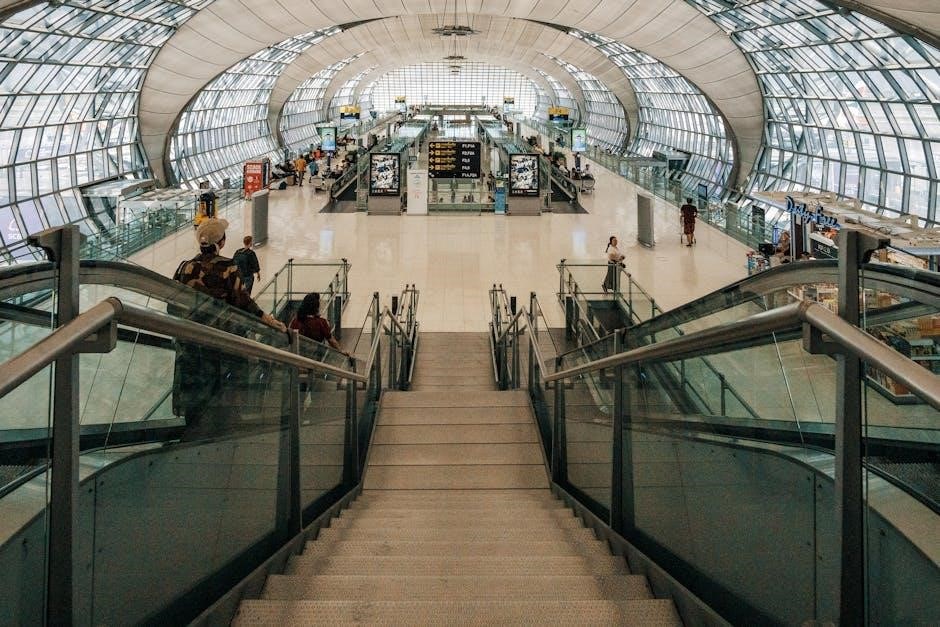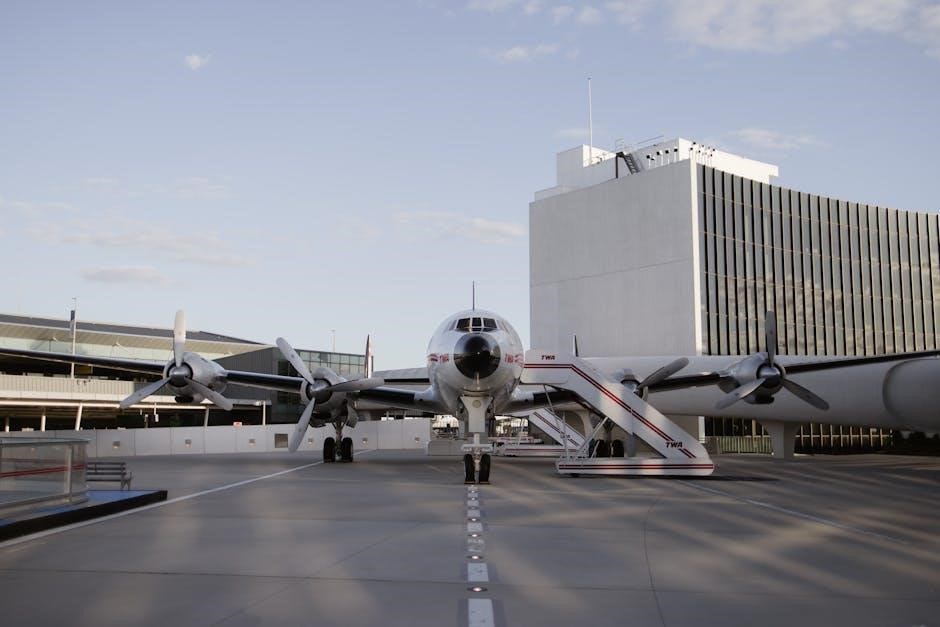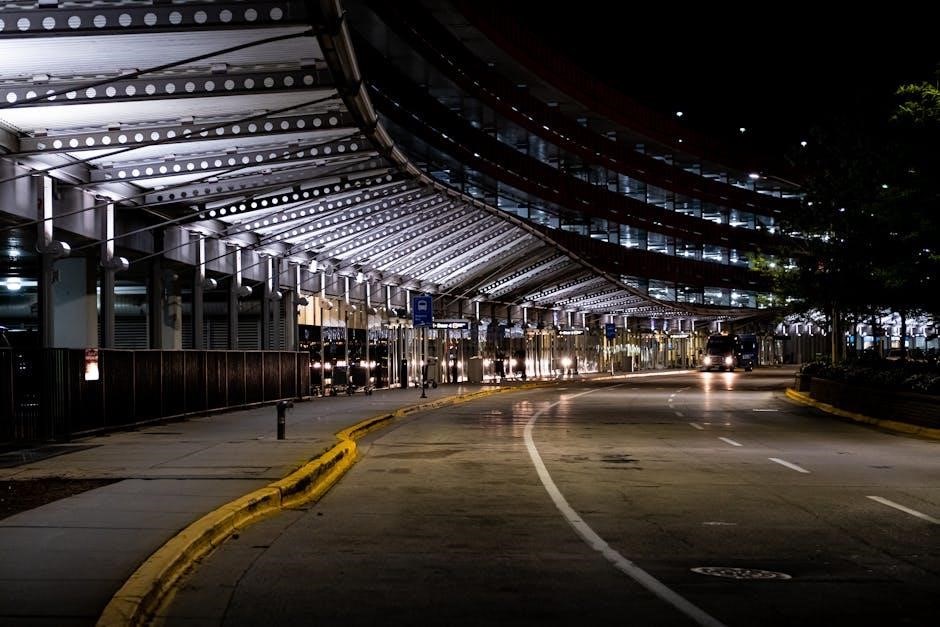Airport terminal design focuses on creating functional, aesthetic, and sustainable spaces that enhance passenger experience, operational efficiency, and cultural identity, while addressing modern challenges and future trends.

Types of Airport Terminals
Airport terminals are categorized into linear, pier, satellite, and compact module designs, each offering unique layouts to optimize passenger flow, operational efficiency, and spatial requirements.

2;1 Linear Terminals
Linear terminals feature a straightforward, rectangular layout with processes arranged sequentially. This design minimizes walking distances and provides a clear flow for passengers, from check-in to boarding. Ideal for small to medium-sized airports, linear terminals are cost-effective and easy to expand. They often have a central concourse with gates aligned on one or both sides, allowing efficient aircraft docking. This configuration simplifies wayfinding and reduces congestion, enhancing the overall passenger experience. Linear terminals are scalable, making them suitable for airports anticipating growth. Their simplicity also supports operational efficiency, as services and facilities can be easily accessed. This design is particularly effective in optimizing space while maintaining functionality.
2.2 Pier Terminals
Pier terminals feature a central processing area with multiple piers or concourses extending outward, each containing gates for aircraft docking. This design excels at accommodating large volumes of passengers and provides efficient connectivity for transfer travelers. The central concourse houses essential facilities like check-in, security, and baggage claim, while the piers allow easy access to aircraft. Pier terminals are particularly effective for hub airports, enabling quick transfers between flights. Their layout minimizes walking distances for connecting passengers and maximizes gate utilization. However, they can be more complex to construct and expand compared to linear terminals. Despite this, pier terminals remain a popular choice for major airports due to their operational efficiency and capacity to handle diverse airline operations effectively.
2.3 Satellite Terminals
Satellite terminals are standalone buildings connected to the main terminal via automated people movers or walkways, designed to handle passenger activities like boarding and baggage claim. These terminals are often used at large airports to alleviate congestion in the main terminal. They provide additional gate capacity and reduce the need for remote stands, enhancing operational efficiency. Satellite terminals are particularly useful for hub airports with high traffic volumes. Their modular design allows for scalability and flexibility, accommodating future growth. However, their reliance on efficient transportation systems between the main terminal and satellite can pose challenges. Despite this, satellite terminals remain a key component in modern airport design, offering improved passenger flow and enhanced user experience.

2.4 Compact Module Terminals
Compact module terminals are designed for efficiency and scalability, often used in smaller airports or specific functional areas like cargo or general aviation. These terminals are modular, allowing for easy expansion as demand grows. They emphasize functionality over aesthetics, making them cost-effective solutions for airports with limited resources. Compact module terminals are ideal for airports needing to optimize space while maintaining operational efficiency. Their streamlined design reduces construction and operational costs, making them sustainable options for smaller-scale operations. Additionally, these terminals can be adapted for various uses, such as low-cost carrier bases or dedicated cargo facilities, ensuring flexibility in meeting specific aviation needs. Their modular nature also supports future upgrades, aligning with long-term airport development goals.
Key Design Objectives for Airport Terminals
Airport terminal design objectives prioritize functionality, aesthetics, sustainability, and flexibility to meet operational needs and enhance passenger experiences while ensuring long-term efficiency and adaptability.
3.1 Functionality and Usability
Functionality and usability are critical in airport terminal design, ensuring seamless passenger flow and intuitive navigation. Terminals must accommodate diverse traveler needs, from check-in and security to lounges and gate access. Efficient layouts minimize walking distances and reduce congestion, while clear signage and technology, like digital wayfinding, enhance the user experience. Additionally, terminals should integrate flexible spaces to adapt to changing airline operations and passenger volumes. The design must also account for accessibility, ensuring ease of use for all passengers, including those with disabilities. By prioritizing functionality, airports can improve operational efficiency and provide a stress-free environment for travelers.
3.2 Aesthetic and Cultural Considerations
Aesthetic and cultural considerations play a vital role in airport terminal design, as they reflect the identity and heritage of the region. Terminals often incorporate local architectural styles, materials, and art to create a unique sense of place. For instance, Helsinki Airport’s terminal design highlights Finnish culture through minimalist aesthetics and natural materials. Similarly, Changi Airport’s Terminal 3 blends modernity with cultural elements, offering a visually stunning experience. These designs not only enhance passenger satisfaction but also serve as ambassadors for the region’s identity. By integrating cultural and artistic elements, airports create memorable spaces that resonate with both locals and international travelers, fostering a sense of pride and connection.
3.3 Sustainability and Energy Efficiency
Sustainability and energy efficiency are critical in modern airport terminal design, aiming to minimize environmental impact while reducing operational costs. Many terminals now incorporate green technologies, such as solar panels, rainwater harvesting, and energy-efficient HVAC systems. Natural lighting and ventilation are maximized to reduce reliance on artificial systems. Materials are often selected for their sustainability, including recycled content and locally sourced options. LEED certification is frequently pursued, ensuring terminals meet rigorous environmental standards. Additionally, waste management and recycling programs are integrated into terminal operations. These practices not only align with global sustainability goals but also enhance passenger comfort and satisfaction, making eco-friendly design a priority in contemporary terminal development.
3.4 Flexibility and Scalability
Flexibility and scalability are essential in airport terminal design to accommodate evolving passenger needs and future growth. Modular designs allow for easy reconfiguration of spaces, such as check-in areas or security checkpoints, as demand changes. Scalable infrastructure ensures that terminals can expand without significant reconstruction, incorporating new technologies or additional capacity as required. Adaptive layouts enable seamless integration of emerging trends, like automated systems or biometric technologies, enhancing operational efficiency. Additionally, flexible terminal designs support multi-use spaces, optimizing resource utilization and improving passenger flow. This adaptability ensures terminals remain efficient and relevant, capable of meeting future challenges and opportunities in the aviation industry while maintaining high levels of service and passenger satisfaction.

Key Considerations in Terminal Design
Passenger experience, operational efficiency, safety, and sustainability are critical. Design must balance functionality, aesthetics, and future adaptability, ensuring seamless flow and security while addressing environmental and cultural impacts.

4.1 Passenger Experience and Flow
Passenger experience and flow are pivotal in terminal design. The layout should ensure seamless movement, minimizing walking distances and providing clear signage. Intuitive navigation reduces stress, while amenities like lounges and dining enhance comfort. Efficient security checkpoints and baggage systems streamline processes, improving overall satisfaction. Designers must anticipate diverse passenger needs, including accessibility for disabled travelers. Technological integration, such as self-service kiosks and real-time information displays, further enhances the journey. By prioritizing user-centric design, airports can create a positive, hassle-free environment that reflects their brand and cultural identity, ultimately fostering loyalty and positive word-of-mouth.
4.2 Operational Efficiency
Operational efficiency in airport terminal design ensures smooth daily operations, minimizing delays and costs. Key factors include streamlined layouts, automation technologies, and multi-functionality of spaces. Modular designs allow flexibility for future expansions and adaptability to changing demands. Efficient baggage handling systems, security checkpoints, and gate allocations reduce bottlenecks. Energy-efficient systems and waste reduction strategies also contribute to sustainability. Designers must balance passenger flow with staff workflows, ensuring seamless coordination between airlines, security, and ground services. By integrating advanced technologies and optimizing resource use, terminals can achieve higher throughput while maintaining safety and passenger satisfaction, ultimately enhancing their competitive edge in the aviation industry.
4.3 Safety and Security
Safety and security are paramount in airport terminal design, ensuring the well-being of passengers, staff, and aircraft. Design strategies include access control systems, surveillance, and emergency response plans. Terminals must comply with international safety standards, incorporating features like fire-resistant materials and clear evacuation routes. Security checkpoints are optimized for efficiency and accuracy, minimizing delays while maintaining high alert levels. Advanced technologies, such as biometric identification and threat detection systems, enhance security protocols. Additionally, terminals are designed to mitigate risks from natural disasters and operational hazards. Regular drills and training ensure preparedness for emergencies. Balancing security with passenger comfort and flow remains a critical challenge in modern terminal design, ensuring a safe and secure environment for all users.
Case Studies in Terminal Design
Changi Airport Terminal 3 and Helsinki Airport exemplify innovative design, blending functionality, sustainability, and cultural identity, earning international recognition for excellence in terminal design and passenger experience.
5.1 Changi Airport Terminal 3
Changi Airport Terminal 3 is a landmark of modern airport design, showcasing seamless integration of functionality and aesthetics. Its sprawling architecture features a glass and steel façade, providing natural light and a sense of openness. The terminal is equipped with advanced security systems, efficient baggage handling, and innovative passenger amenities. Sustainability is a key focus, with energy-efficient systems and green spaces incorporated throughout. The terminal also boasts unique attractions, such as the Butterfly Garden and movie theaters, enhancing the traveler experience. Its design emphasizes passenger comfort, operational efficiency, and cultural identity, setting a benchmark for future airport terminals worldwide.
5.2 Helsinki Airport Terminal
Helsinki Airport Terminal, designed by Finavia, stands out as a prime example of modern airport design, earning recognition in the prestigious Prix Versailles 2022 competition. The terminal seamlessly integrates functionality, sustainability, and cultural identity. Its design emphasizes natural light, open spaces, and the use of local materials, such as wood, to create a warm, Nordic aesthetic. Sustainability is a cornerstone, with geothermal energy and solar panels reducing environmental impact. The terminal prioritizes passenger comfort, offering clear signage, efficient layouts, and amenities like lounges and dining options. Its design reflects Finnish culture while maintaining global connectivity, making it a benchmark for airport terminals in balancing aesthetics, functionality, and environmental responsibility.

Future Trends in Terminal Design
Future trends in airport terminal design emphasize sustainability, technology integration, and passenger-centric experiences. Biometric systems and AI-driven operations are expected to enhance efficiency and security. Modular, flexible designs will adapt to evolving demands, while green technologies like solar panels and geothermal energy reduce environmental impact. The use of smart materials and renewable resources will become more prevalent. Airports will also prioritize cultural and local influences in their designs. Seamless connectivity and digital wayfinding will improve passenger navigation. These innovations aim to create terminals that are not only functional but also iconic, reflecting the identity of their locations while addressing global challenges and passenger expectations for comfort and efficiency.
Airport terminal design is a complex yet vital aspect of modern aviation, balancing functionality, aesthetics, and sustainability. Effective terminal design enhances passenger experiences, operational efficiency, and cultural identity while addressing environmental and technological advancements. By integrating innovative materials, biometric systems, and sustainable practices, future terminals will set new standards for connectivity and comfort. The evolution of terminal design reflects global challenges and opportunities, ensuring airports remain central to transportation networks. Ultimately, well-designed terminals not only facilitate travel but also serve as iconic symbols of progress and innovation, shaping the future of air travel for generations to come.

